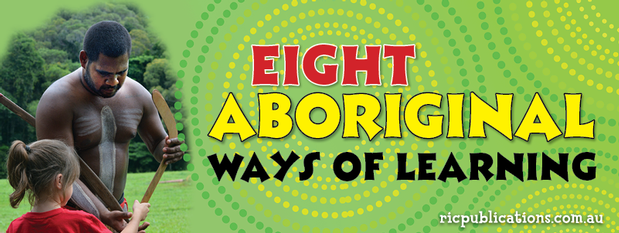- Tuesday 20 September 2016
- 0 Comments
Teachers working with Aboriginal and Torres Strait Islander (ATSI) students, or those wishing to incorporate more ATSI history and culture, may be interested in 'Eight Aboriginal ways of learning'. It describes ways teachers can use culturally-appropriate frameworks to develop teaching and learning activities and give students a deeper understanding of ATSI culture.
‘Eight Aboriginal ways of learning’ describes the following processes:
- Learning through narrative
- Planning and visualising explicit processes
- Working non-verbally with self-reflective, hands-on methods
- Learning through images, symbols and metaphors
- Learning through place-responsive, environmental practice
- Using indirect, innovative and interdisciplinary approaches
- Modelling and scaffolding by working from wholes to parts
- Connecting learning to local values, needs and knowledge
Many websites relate ‘Eights ways of learning’ in the following simple terms:
‘Think and do. Draw it. Take it outside. Try a new way. Watch first, then do. Share it with others.’
How does this relate to classroom teachers? Use some of these ideas.
- Story sharing. Tell stories to relate a maths problem and make it more true-to-life. Then have students make up their own stories. Allow time for sharing personal stories such as during ‘News’ time. Relate stories about historical figures by reading extracts from their diaries.
- Learning maps. Decide topics for learning that fit the curriculum as a class, and also the ways to learn them—computer research, library visits, excursions, project-based and so on. Use KWL charts to find out what students know, want to know and have learnt to map their learning journey. Students have ownership of learning if they are involved in decision-making.
- Non-verbal. Use a variety of methods other than verbal to teach and elicit responses from students. Students learn by seeing, hearing, feeling, thinking, doing and making things. They share with others using facial expressions and body language. Hands-on activities support this way of learning.
- Symbols and images. Not all students can relate well what they’ve learnt in a story. Consider allowing students to use an artwork, a model or objects to show what they know.
- Land links. Use the environment for learning. Could a maths problem be done using rocks, leaves or flowers? What do the plants and animals in an environment tell about how the people lived there? Or simply think about what types of learning could take place outside rather than in a classroom.
- Non-linear. Students put new and different ideas together to create new knowledge. Collaborative activities allow students to share ideas and incorporate these into their bank of knowledge.
- Deconstruct and reconstruct. This process involves working from ‘wholes’ to ‘parts'. This strategy works particularly well in English. Students can read a text and ‘deconstruct’ it to see how it was put together. Then they can create their own using this knowledge. An important part of this process is ‘watching and doing’—demonstrating to students and allowing them to 'have a go'.
- Community links. Link the school and classroom to the community. Invite speakers and experts to share their expertise. Make connections between what the students are learning in class to real-life and how they can use their learning to ‘help their mob’ (family or community).
Many classroom teachers will find they already use many of these learning strategies, but have they made it obvious to students that the way they are learning is the way traditional Indigenous Australian children also learn?
Some interesting websites for more information are listed below. Check them out.
- http://8ways.wikispaces.com/
- https://vickidrozdowski.files.wordpress.com/2012/10/individual-investigation-of-a-learning-theory-aboriginal-pedagogy.pdf
- https://pstblogger03.wordpress.com/
- https://sites.google.com/site/englishk6chatpapers/issues/issue-three---aboriginal-torres-strait-islander-histories-cultures-english
